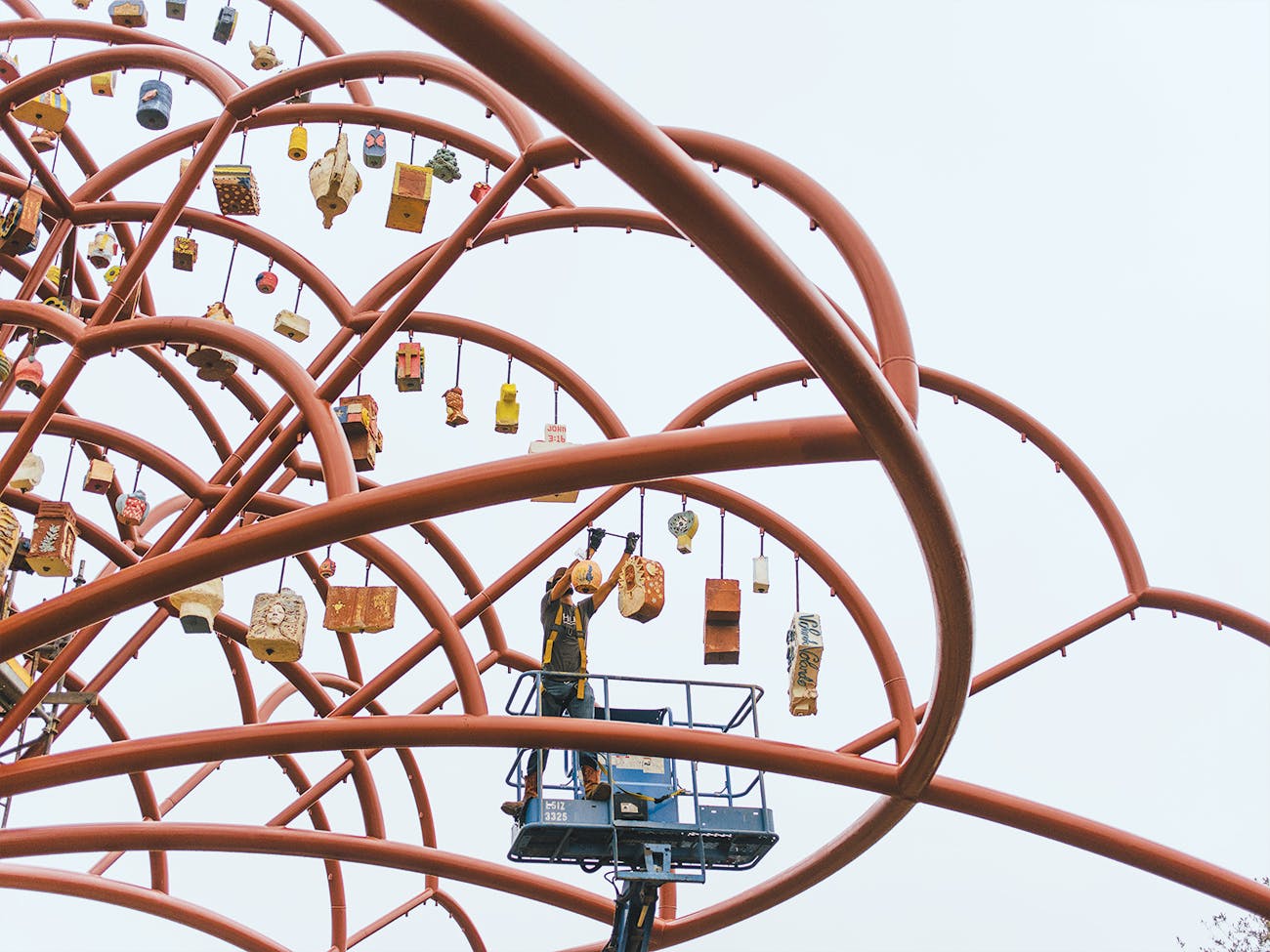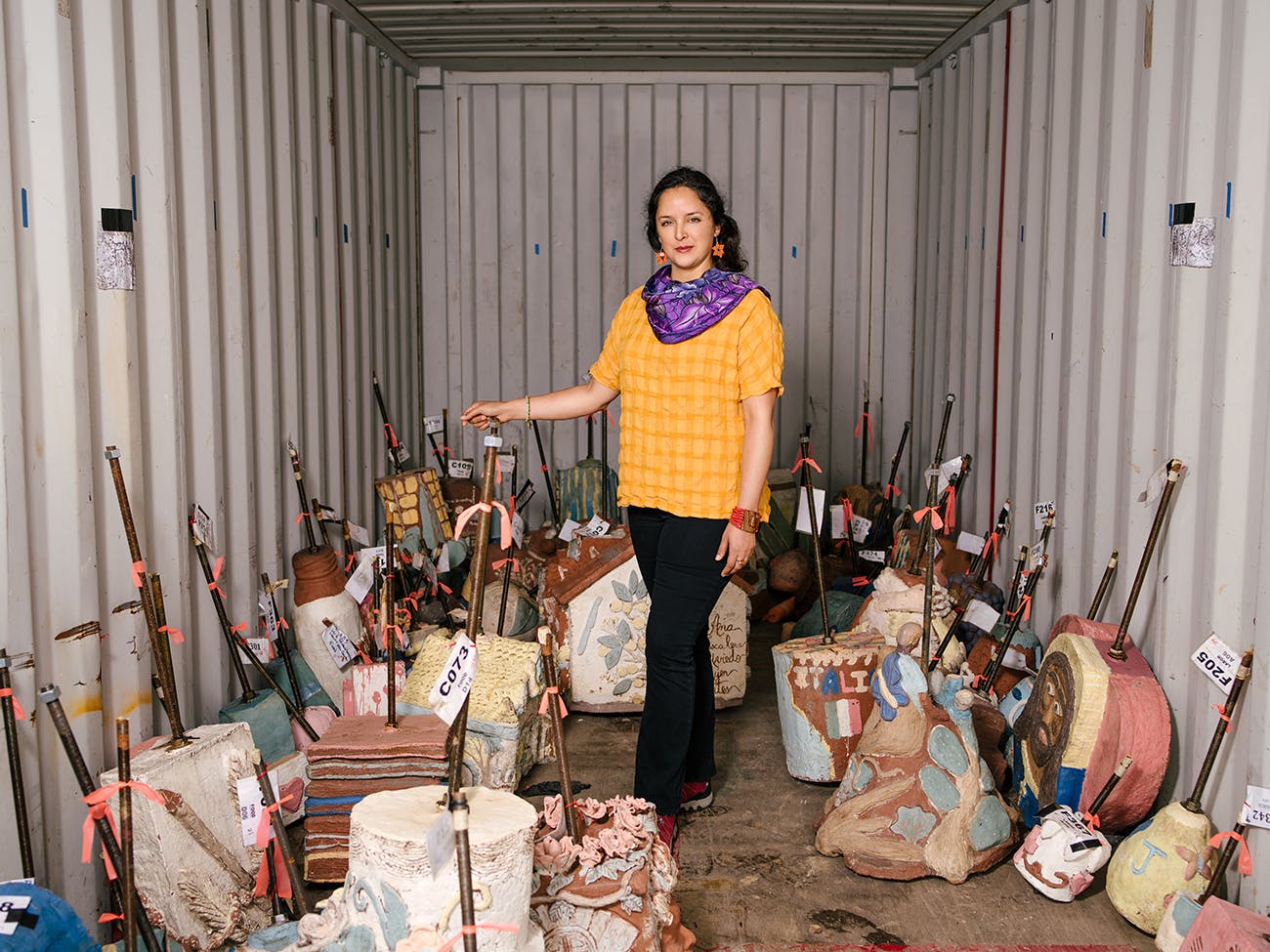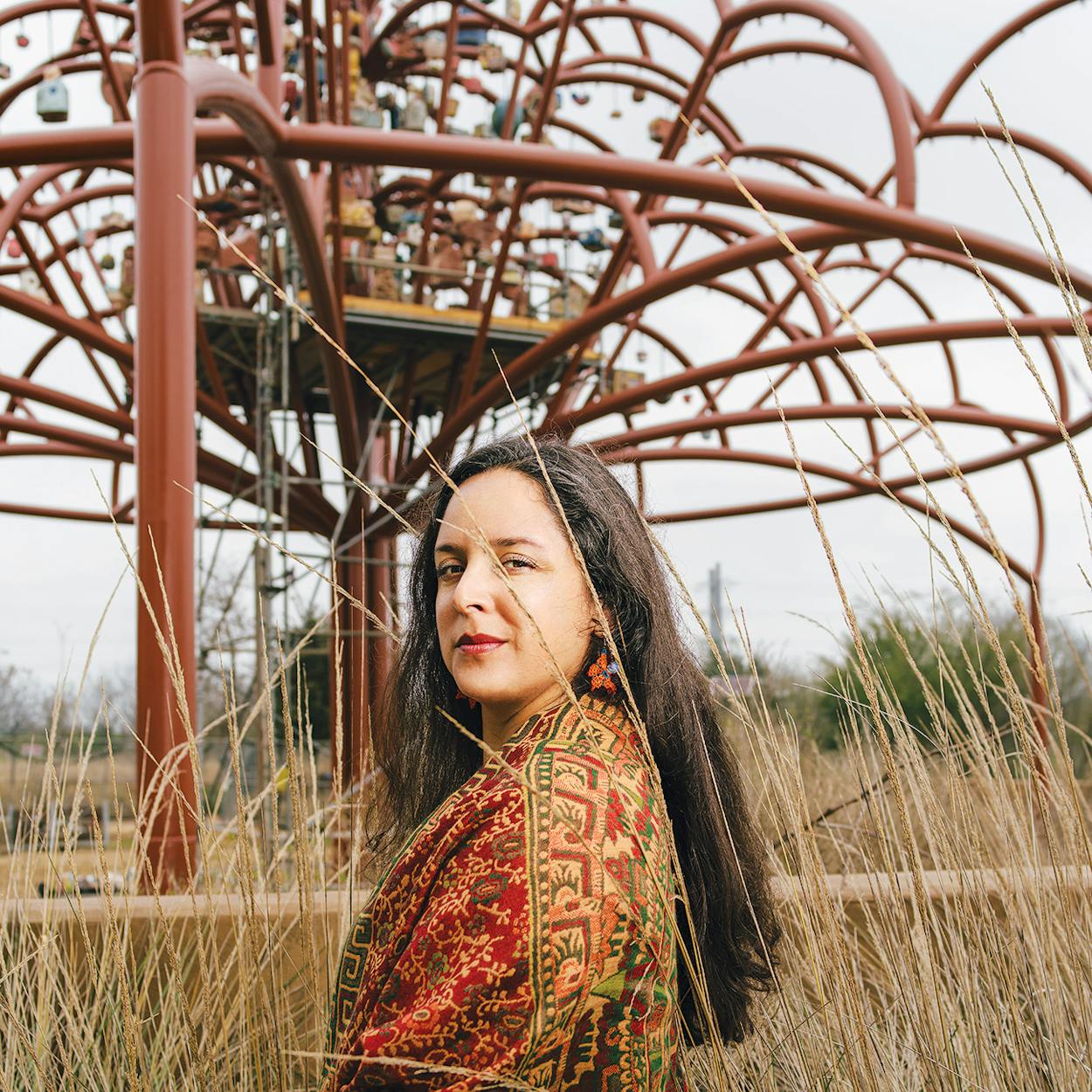On a warm December day in the far southern reaches of the San Antonio River Walk, on a spur path to the sleepy Mission San Francisco de la Espada, a massive steel structure—eighty feet in diameter and forty feet tall—spreads its arms above the South Texas scrub. Branching out in a curving canopy from a slender central trunk, this monumental public artwork is, for now, leafless, a work in progress. Artist Margarita Cabrera, standing beneath the gazebo-like structure, directs a team of painters putting finishing touches on the reddish-brown boughs of her Árbol de la Vida.
Just uphill from the installation site, packed away in twenty-foot shipping containers in a dusty parking lot, the greater part of Cabrera’s vision lies in wait: the more than seven hundred elaborate sculptures that will eventually hang on the Árbol’s frame like Christmas ornaments. Cabrera shows off the heavy clay sculptures—each made by a local nonprofessional artist—with pride and no small physical effort, turning and lifting them by thick steel rods attached through their centers in preparation for overhead suspension. Cabrera is hesitant to pick favorites, but those she hurries to display include a knee-high feathered hat commemorating an eighteenth-century “cattle queen” who reportedly died in possession of a million acres of land in the Rio Grande Valley; a television set that commemorates KWEX Channel 41, the pathbreaking Spanish-language station that would eventually become the charter affiliate of Univision; and a replica of a drive-in movie theater showing John Wayne’s tribute to local history, The Alamo, which premiered in San Antonio in 1960.
Nearby are sculptures that pay homage to local Jewish, Chinese American, and Native American communities as well as to local industries and agricultural trades: railroad ties, a saddle, and, everywhere, animals, fruits, and vegetables in abundance. The result is exactly as Cabrera intended. Árbol de la Vida: Voces de Tierra conjures and encompasses the vast array of cultures that make up today’s modern South Texas metropolis.
The permanent installation, located on one of the less-touristy stretches of the River Walk, was commissioned by the San Antonio River Foundation as the final and most ambitious of several “public art portals” meant to guide walkers and bikers up the river trail toward the four UNESCO World Heritage Site missions located by the waterway. Cabrera initiated the project in 2017 with a series of charlas, or “chats,” public events at which people from across the city shared their stories or the stories of their families. Hundreds of the participants then created sculptures inspired by those tales.
Though Árbol de la Vida won’t open until May, Cabrera believes that the true fruits of her labor are already being realized. “You can see in all of these pieces the incredible effort, love, and passion that has gone into them by artists who have never had this kind of experience or opportunity,” she says, rummaging through a storage container for more gems to share. “Now they are experts in craft-making. We have seven hundred new artists and potential art teachers in the community.”

Cabrera, who is in her mid-forties, represents a different sort of artist than the archetypal virtuoso who captures personal visions in paint or marble. Over the past decade-plus, she has pioneered a unique practice of community-based art focused on educating people, often immigrants and women, in traditional Mexican handicraft methods and helping them to assemble works for public display.
Cabrera’s work has been shown in most of the major public collections in Texas as well as several important museums across the country, including the Los Angeles County Museum of Art and the Smithsonian. Though she has worked extensively in sculpture, watercolor, and prints made by her own hand, she’s known primarily for the art she has organized others to do.
Another of Cabrera’s community-based projects, Space in Between, was shown earlier this year at the Dallas Contemporary as part of “Es Imposible Tapar el Sol Con un Dedo” (“It Is Impossible to Cover the Sun With a Finger”), a larger exhibit of Cabrera’s work. For Space, Cabrera ran workshops in which she taught her collaborators to sew soft-sculpture desert flora using an embroidery style associated with the Otomí people of central Mexico. It’s important to Cabrera that her workshop collaborators, many of whom are people of Mexican descent, learn about the rich and often ancient folk traditions of their ancestral land. “I always introduce histories from the beginning so we can learn about who we are and where we come from,” Cabrera says. “Then, of course, we get inspiration to innovate as people share their knowledge in creating something new together.”
Space in Between’s pillowy interpretations of plants native to the arid Southwest—over forty yucca trees, prickly pears, saguaros, agave, and other plants—were constructed using material from discarded U.S. Border Patrol uniforms that were then embroidered with Otomí-style images and text relating to the artists’ own immigration stories. One shows the dramatic trials of a group of migrants who used a steel beam to puncture a hole in a closed container truck where oxygen was running out. Another pays tribute to the embroiderer’s mother, who died before the artist could cross back over the border to visit her in Mexico.

The Origin of Space
The title of Cabrera’s Space in Between is derived from nepantla, an Aztec word for the experience of being between things. Texas writer Gloria Anzaldúa popularized the use of the term in Chicano and border studies.
Space in Between began as a collaboration between Cabrera, the Houston gallery Box 13 ArtSpace, and the nonprofit Houston Interfaith Worker Justice Center (now called Fe y Justicia Worker Center), which helped connect Cabrera with the immigrants who would become her collaborators. “She was really humble in terms of listening to those who knew more about the community and what we needed,” says center cofounder Pancho Argüelles. “She wasn’t just lost in her own project. She had her eyes open to the actual people that showed up.”
Cabrera spent her early life in Mexico City, encouraged to explore her creative side through Montessori education. Her engineer father moved the family to Salt Lake City when Cabrera was ten. She remembers her initial immigrant experience in Utah as a period of isolation, and she started to spend much of her free time making art. The family later moved to El Paso, and in high school Cabrera began to develop an awareness of immigrant and border-region social issues. Later, after graduating from art school at Hunter College, in New York, Cabrera toured maquiladoras, the transnational factories employing poor northern Mexicans just south of the Rio Grande. She remembers them as controlling places full of suspicion, with toxic work conditions.
Cabrera, who has lived in San Antonio since 2017, conceived her art practice in opposition to the degrading reality of labor along the border. “The way in which we work in community completely opposes the way in which I experienced the maquiladoras,” she says. “For instance, we have convivimos alegremente. We’re happy. We look forward to work. We share meals. We have music. We share stories. We’re making products that celebrate who we are, and we’re offering them to communities that are accepting of who we are.”
Most of Cabrera’s inspirations lie in the colorful realm of Mexican popular arts and crafts, a world she was exposed to as a child when she visited relatives in her native country. Her focus on handmade objects also echoes the Arts and Crafts movement of the nineteenth century, which opposed the dehumanization of the industrial revolution by restoring an appreciation for the aesthetic traditions of cottage industry. Other regional Mexican craft styles that Cabrera has drawn from for her community projects include Oaxacan alebrijes (those unfamiliar with Mexican folk art may recognize them as the flying creatures in Disney’s Coco) and the papel picado (festive banners of cut-up tissue paper) associated with San Salvador Huixcolotla, Puebla.

Then, of course, there’s the árbol de la vida clay and ceramic tradition, which Cabrera first encountered as a young woman visiting family in Acatlán, Puebla. Dating back to the evangelization of central Mexico, artisan-made árboles are typically flattened perspectives of trees teeming with colorful forms including flowers, fruit, and characters from Bible stories. An árbol might be small enough to set on a table or large enough to be displayed like a Christmas tree. In Cabrera’s voluminous version, the tree becomes a repository for the stories of the city’s residents—landowner and ranch hand, citizen and noncitizen, people of every race and culture. Robert Amerman, head of the San Antonio River Foundation, calls the project “an amazing love letter to San Antonio.”
Even the people helping Cabrera transport and mount the Árbol sculptures are part of the art-making. On our way to the shipping containers, Cabrera introduces me to Frederico Avila, who has been a laborer on the project for over a year. Avila also made a sculpture for the tree: a replica of the Tower of the Americas, the landmark observation tower with a revolving restaurant that was built for the 1968 World’s Fair.
Avila tells me that his father helped build the actual tower after emigrating from Mexico. Avila’s clay sculpture of the tower is ringed by the names of his family members, including his own children, all of whom are forever tied to the history of San Antonio, the tower, and, now, the Árbol de la Vida.
“There are so many people of this community that are part of the creation of this city,” Cabrera says. “This tree is allowing us to tell that story.”
Austin writer Michael Agresta’s work has appeared in Slate and the Wall Street Journal.
This article originally appeared in the April 2019 issue of Texas Monthly with the headline “A Tree Grows in San Antonio.” Subscribe today.
- More About:
- Art
- San Antonio







